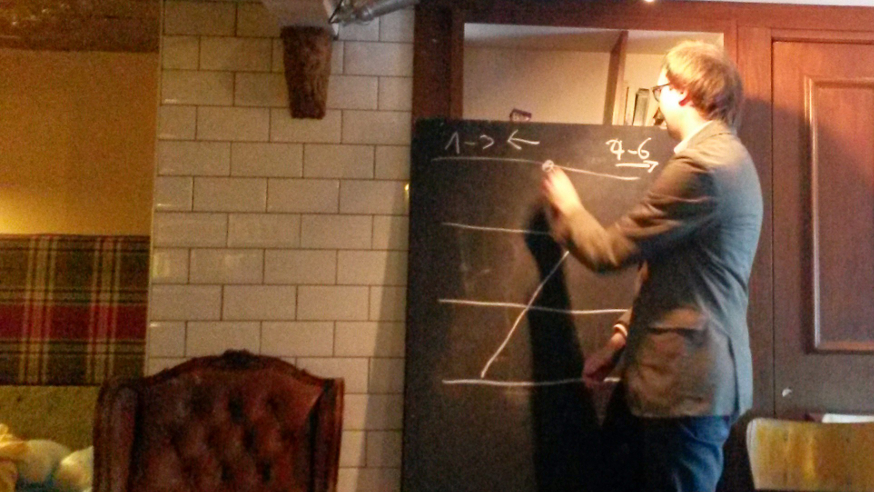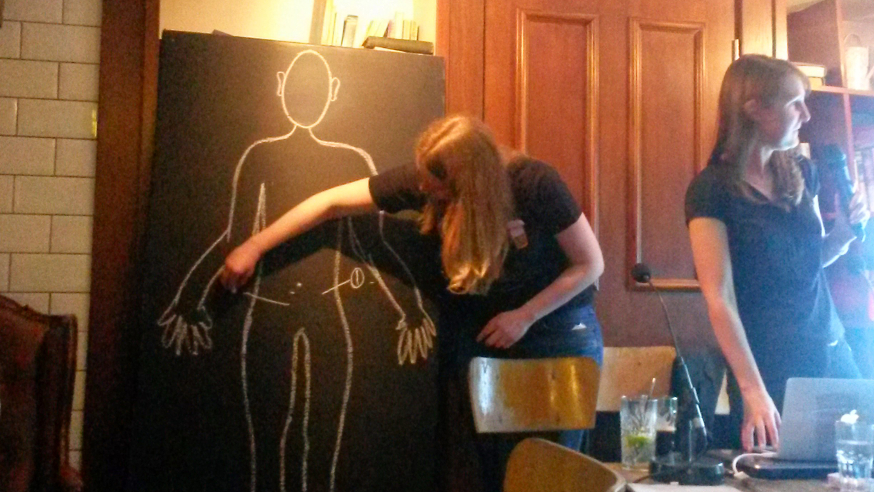Martin Menten, Dr Sarah Gulliford, and Dr Emma Harris had come together to host an evening of pub science – part of the international science festival, Pint of Science. It’s one of the world’s largest science festivals – taking place over 3 nights, 9 countries, and 50 cities this year.
All three of our speakers receive support through the Cancer Research UK Centre at the ICR and The Royal Marsden. This evening, they were talking about work at the ICR on ‘Tracking Tumours’. I was acting as compere, and as the room filled with people clutching chips and drinks, I was looking forward to an exciting and interactive evening.
'Nothing stays the same'
Martin kicked off the evening with his presentation – ‘Nothing stays the same; How anatomical changes influence radiotherapy’. The opening of the talk was aimed at introducing the audience to the fundamentals of cancer and radiotherapy – how it works, how it is used in treatment, and the complex calculations required to figure out where a particle will deposit its energy in a patient.
To illustrate how particle paths are calculated with Monte Carlo simulations, Martin called up an audience volunteer to determine the path of a particle on our chalkboard by rolling a dice. We shook the dice for three particles – now try it for each of the millions of particles involved in modern radiotherapy!

The talk came to a close with Martin focusing on anatomical changes in patients. These changes– over seconds, hours, or even the several weeks of treatment – have an impact the effectiveness of radiotherapy. He spoke about the future possibilities of ‘real time adaptive radiotherapy’ to compensate for the movement of tumours and organs.
Calculating radiotherapy dose
The next talk was delivered by Sarah, and opened with a fitting game for a pub – a round of “would you rather?” Choosing between skill in languages or music may seem easy, but what about the side-effects of radiotherapy? Sarah talked about the way information from clinical trials helps her perform research into the toxicities associated with radiotherapy. A couple of the attendees had worked on the study she referenced, and were happy to think about how much radiography techniques had improved, even over the last 10 years.
Sarah went on to speak about how we use the concept of organ architecture to calculate doses – something she loves because, as a physicist, it reminds her of circuit diagrams! In her work, she uses mathematical techniques to map the three-dimensional data from the body onto histograms, to study how much dose nearby healthy tissues are receiving. Sarah closed by describing the further research needed to discover why some people react less well to radiotherapy than others, and by thanking all the patients who participate in clinical trials.
It was time for a break, and as people got more drinks – or took part in the interactive, tumour treatment planning game Sarah had bought along – I had the chance to chat with some of the audience members. The two radiographers were thrilled to see so many people had come out to learn about the physics of radiotherapy, and all over the room, everyone seemed to be having a great time, settling down and chatting about what they’d learnt.
'Listening to tumours'
After the break, we got back to the business of the evening with Emma’s talk – ‘How listening to tumours helps guide cancer therapy’. We began by running through what ultrasound is – and a run-through of the early history of its use in science. One early experiment involved blindfolded bats! The lure of a free T-shirt enabled the audience to come up with many more animals that use ultrasound – including the moth.
Emma moved on to talking about ultrasound in the body – and how we use it to track moving tumours. Her talk concluded by mentioning how ultrasound can help us achieve more accurate and personalised radiotherapy by allowing us to monitor the changes within the body, which Martin had described.
Then it was time for the quiz. Four teams competed to identify organs on an ultrasound scan – and we revealed their locations on our trusty pub chalkboard. (Rumours that the author of this blog failed to accurately place the liver on the body are completely unfounded!)

With prizes handed out, all that was left was to thank the fantastic audience, and our speakers for coming along. It was an incredibly positive evening, and I hope an enlightening one.
comments powered by